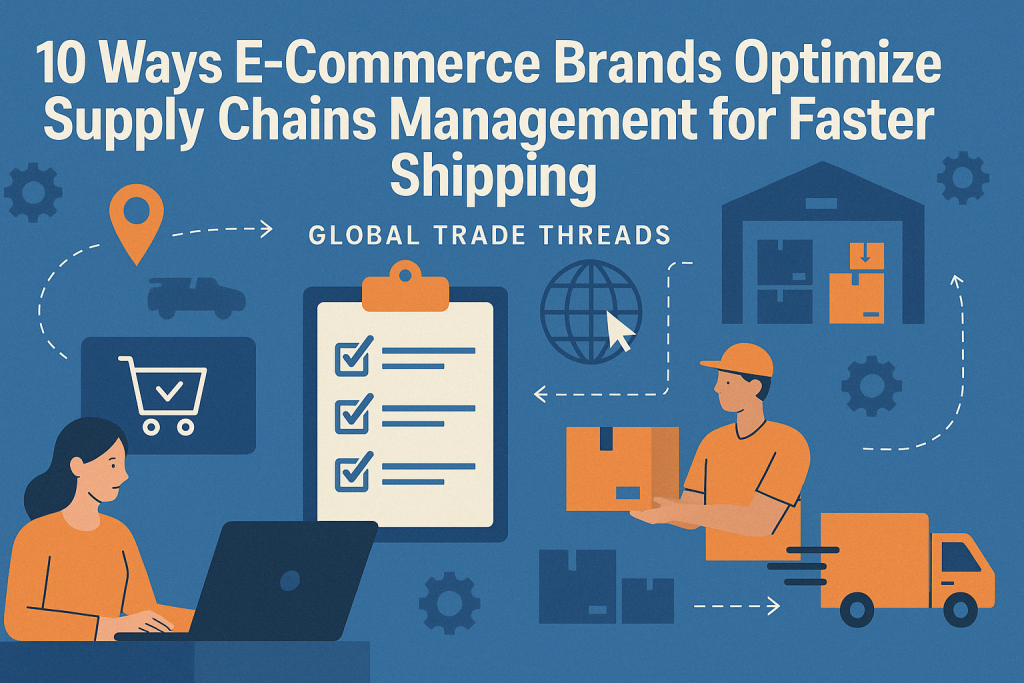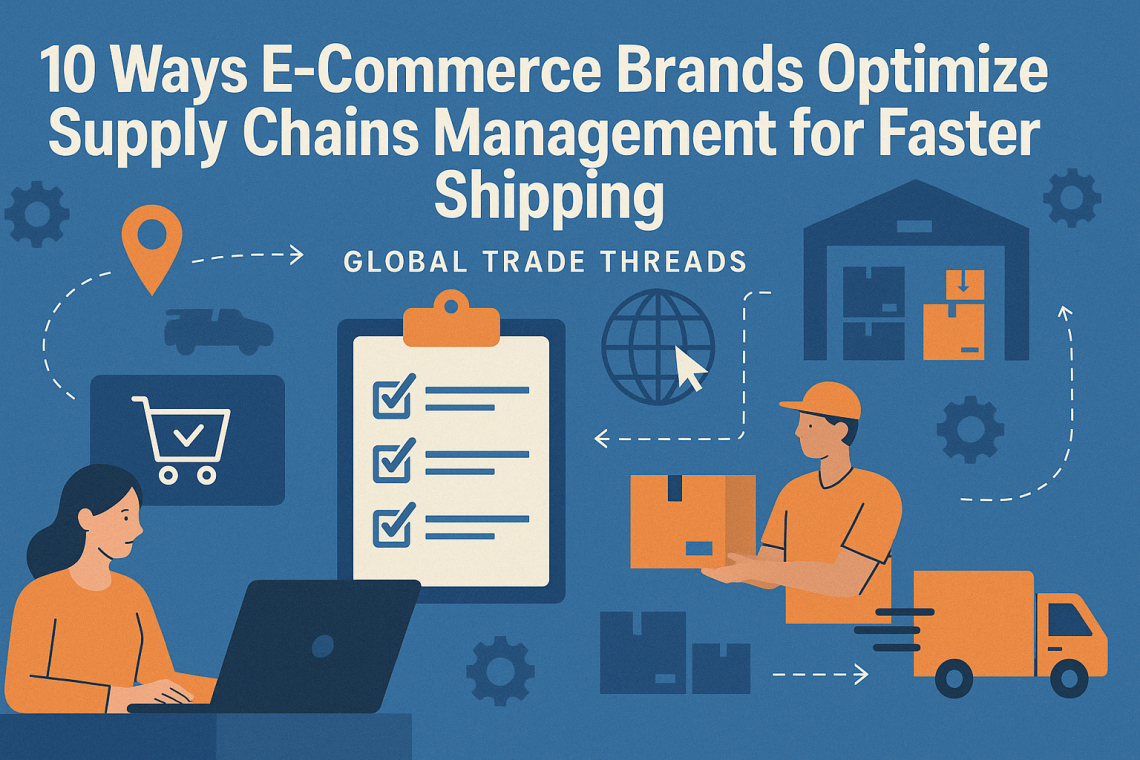E-commerce brands face constant pressure to ship products faster while keeping costs in check. To stand out in a crowded market, many companies are rethinking their supply chains management practices.
By adopting new technology, forming stronger partnerships, and using smarter data analytics, merchants can move their products more quickly while avoiding common bottlenecks. In this post, we explore 10 proven methods for boosting shipping speeds and ensuring a more reliable shopping experience for customers.
Supply chains management is about more than just moving items from one point to another. It involves predicting demand, scheduling production, and ensuring your warehouses and delivery routes are fully optimized.
According to research, 31% of companies currently use predictive analytics in their supply chain operations, with 48% planning to adopt more advanced approaches soon (esoftskills.com). This move toward predictive analytics can lead to a 15-25% increase in overall operational efficiency. Below, we break down 10 effective ways e-commerce brands can optimize supply chains management to achieve faster shipping times.
1. Use Predictive Analytics to Transform Supply Chains Management
Way #1: Leverage Big Data for Demand Forecasting
Predicting consumer demand has always been a challenge for e-commerce brands. However, big data and machine learning are changing the game. By collecting data from past sales patterns, social media trends, and relevant economic indicators, companies can more accurately forecast the quantities needed for each product.
This shift isn’t just guesswork: data shows that companies focusing on supply chain visibility can reduce out-of-stock items by 50% and improve perfect order delivery by 10% (esoftskills.com). With better forecasts, you can stock your warehouse properly, reducing wasted storage space and shipping delays.

Way #2: Implement Predictive Maintenance
Predictive analytics aren’t just about customer demand—maintenance data is also critical. If you operate your own delivery fleet or use large-scale production equipment, minor breakdowns can result in major shipping delays.
Predictive maintenance strategies use sensor data and machine learning to detect early signs of wear and tear before complete failures occur. Research indicates that predictive maintenance can reduce unplanned maintenance costs by 25-50% (esoftskills.com). By keeping vehicles and machinery running smoothly, you streamline production and shipping processes, ultimately helping orders move out the door faster.
2. Develop Strong Supplier Partnerships and Visibility
Way #3: Establish Trust and Transparency
Building a solid relationship with suppliers is essential for e-commerce brands looking to optimize shipping times. In fact, a recent study found that 60% of companies claim comprehensive visibility of their direct suppliers, but only 30% have visibility further down the line (ft.com). Improving transparency can ensure the timely flow of materials, reduce the risk of factory shutdowns, and maintain consistent quality levels.
You can achieve this by setting clear expectations, sharing forecasts, and regularly checking in on the production process.
Way #4: Use Real-Time Collaboration Platforms
Forging close ties with your suppliers is easier when you use technology to stay connected. Software solutions like SAP EWM (Extended Warehouse Management) or Blue Yonder’s supply chain platform enable live collaboration and visibility across your entire supplier network. These tools allow you to quickly spot production slowdowns or shipping delays.
Some platforms, like Project44 and Shippeo, specialize in real-time transportation visibility. By knowing where your shipments are at all times, you can greatly reduce the odds of misplaced cargo and inform your customers of any changes.
3. Implement Real-Time Shipment Tracking for Smarter Supply Chains Management
Way #5: Adopt GPS, RFID, and TMS Solutions
Real-time shipment tracking is produced by combining GPS trackers, radio frequency identification (RFID), and Transport Management System (TMS) software. Though many businesses have these technologies in place, few integrate them seamlessly across borders and various modes of transport. Implementing these solutions effectively can help you predict arrival times and label potential bottlenecks.
According to industry reports, improved real-time visibility can reduce out-of-stock items and boost perfect order rates—a key advantage in e-commerce supply chains management.

Way #6: Analyze Data to Preempt Disruptions
Real-time tracking gives you data on your shipments’ locations, but the real power lies in analyzing this data to predict future disruptions. For example, if a shipment to a busy port is delayed, you can swiftly reroute cargo or negotiate a backup plan with your carrier.
Continuous monitoring can also increase business agility by 10-15% (esoftskills.com). By staying one step ahead, e-commerce brands can maintain consistent shipping times and keep customer satisfaction levels high.
4. Optimize Warehouse Operations to Strengthen Supply Chains Management
Way #7: Automate Warehouse Processes
Warehouse automation can speed up handling times, lower labor costs, and reduce human error. For instance, robotic picking systems can streamline order fulfillment, and automated storage solutions can help you better utilize warehouse space.
With global demand for faster shipping, it’s more important than ever to reduce manual sorting and picking tasks. Companies such as SAP offer Extended Warehouse Management solutions that make it easier to route items, manage inventory, and track where products are stored. This minimizes wasted effort and ensures each item is ready to be shipped without delay.
Way #8: Use Tools Like SAP EWM
Automation alone isn’t enough; you also need the right warehouse management software to coordinate these processes. SAP EWM is a powerful tool for seamlessly managing inventory, tracking inbound and outbound goods, and forecasting future demands.
Similarly, Lokad uses machine learning to create predictive supply chain optimization models for improved decision-making. By integrating solutions like these, e-commerce brands gain a bird’s-eye view of inventory levels, which helps them schedule picking and packing more accurately. This allows ready-to-ship packages to flow quickly through the warehouse.
5. Enhance Overall Logistics Efficiency to Boost Supply Chains Management
Way #9: Focus on Last-Mile Delivery Strategies
No matter how efficient your production or warehouse processes are, poor last-mile delivery can slow shipments and disappoint customers. Last-mile delivery is the final stage where your product reaches the buyer, and it’s one of the most expensive segments of shipping. To optimize this step, consider working with local delivery providers that specialize in smaller, faster routes.
Alternatively, you can use real-time logistics data from companies like GoComet or Shippeo to identify the most cost-effective carriers. Whether you’re delivering from an overseas factory or a local warehouse, focusing on last-mile efficiency is a surefire way to strengthen supply chains management.
Way #10: Continuously Evaluate and Adapt
Global market shifts can happen quickly. For instance, the COVID-19 pandemic highlighted how fragile international supply chains can be, with rapid changes in demand creating bottlenecks across industries (ft.com).
Implementing continuous assessment of shipping methods, supplier reliability, and changing consumer patterns keeps your operations ahead of disruptions. Regularly examining your carriers’ performance, looking for new technology trends, and updating your forecasting methods will keep your supply chains management strategies agile.

Conclusion
Supply chains management is vital to delivering products quickly and reliably in an ever-competitive e-commerce sector. Through predictive analytics, stronger supplier relationships, real-time shipment tracking, warehouse optimization, and continuous evaluation, your brand can streamline operations and shorten delivery times.
Studies show that integrating these methods effectively can reduce inventory costs by as much as 20-50% and speed inventory turnover by 10-30% (esoftskills.com). This not only keeps your customers happy but also allows your business to scale up in a sustainable way.
Whether you’re just starting or rethinking your global manufacturing process, focusing on supply chains management improvements provides a major competitive edge. By carefully adopting these 10 strategies, e-commerce brands can stay agile, respond to market changes, and ensure that each shipment reaches customers both quickly and cost-effectively.


